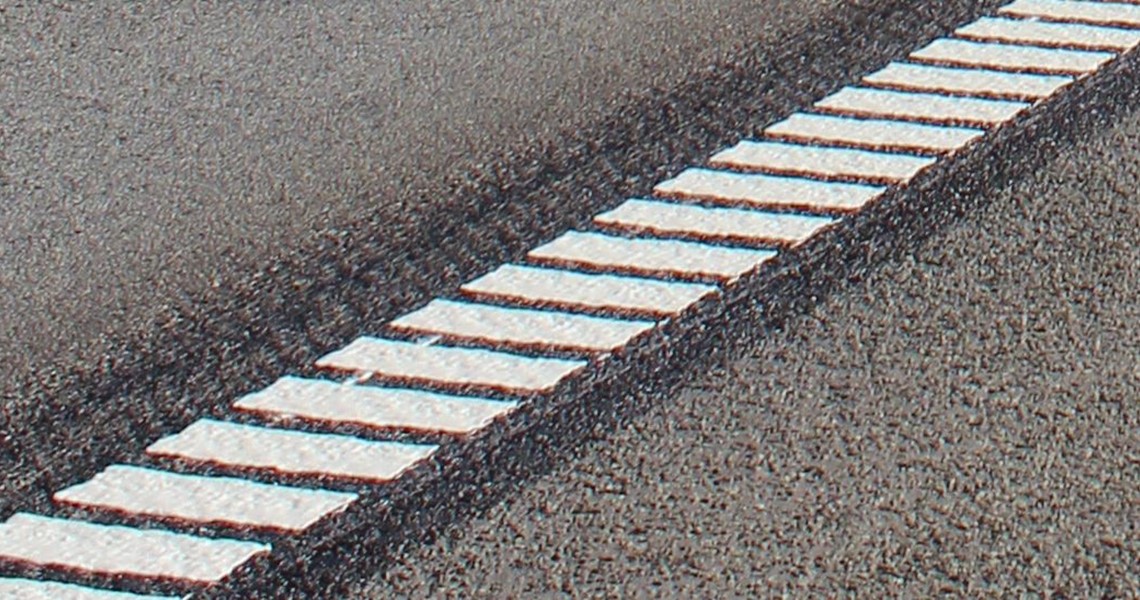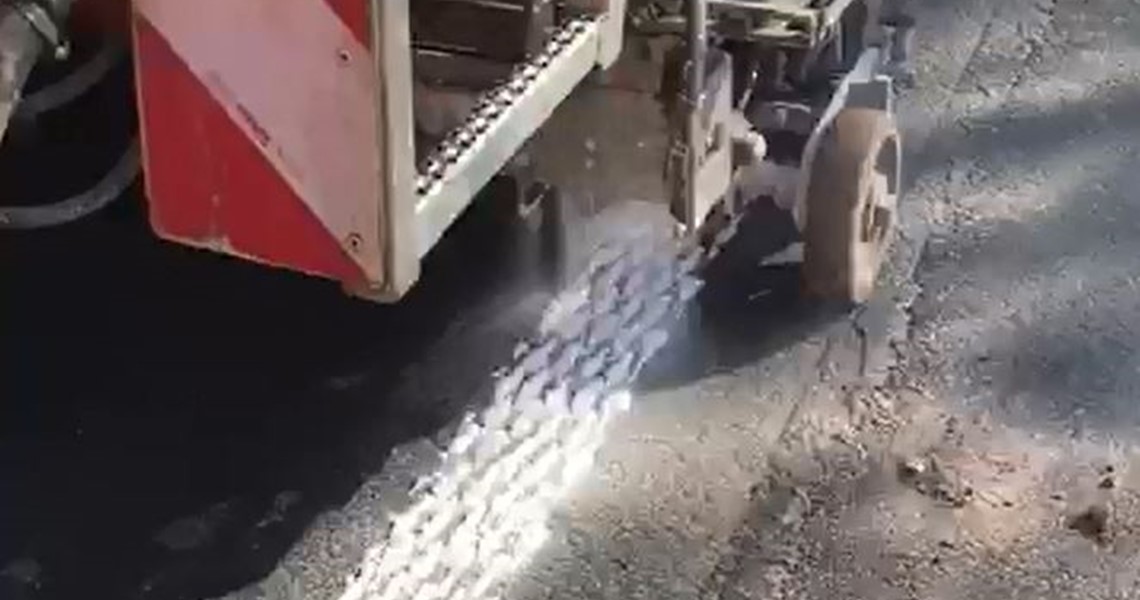Thermoplastic spray applications are used for applying flat lines, also known as non-profiled or type 1 markings. Flat lines are mainly used in well-illuminated areas as urban roads for e.g. where the lines do not need high retroreflectivity levels.
Extrusion applications are used for applying both flat lines (also known as non-profiled or type 1 markings) and profiled markings (also known as structures or type 2 markings).
Profiled road markings are the newest road marking technology where a part of the road marking typology is raised over the road surface. This type of markings are becoming more and more popular because of the increased road safety it provides due to high visibility in wet conditions and at night, as well as the acoustic warning you get when driving on the line.
Based on your requirements and the line types you require, Borum can supply you with a variety of application equipment.
Read more below.
THERMOPLASTIC SPRAY APPLICATIONS
Thermoplastic spray via pressurized tank
Line types: Flat lines (continuous and interrupted lines)
Equipment: BM SP 2500 Spray plastic gun
(Optional narrow nozzle size of 3 mm or wide nozzle size of 7 mm)
The amount of product that is put on the road is regulated by the pressure of the tank and the pressure of the sprayed air. In other words, the application pressure is kept at the same level as in the pressure tank. This offers you an easy to use system.
After starting the application, the thickness of the line is only affected by the machine speed. Therefore, it is necessary to keep a constant speed in order to maintain a uniform and consistent line thickness. This is useful for applying thicker lines in curves and areas with higher wear and tear levels.
The maintenance for the pressure tank is minimal if compared to the thermoplastic spray pump system. Furthermore, due to not having a pump, the system has less mechanical parts that can be worn out in the time.
- Material pressure is created by the compressor
- The pressure tank can handle 8.5 bar, but usually, a pressure of 1-5 bar is used
- The atomizing air pressure is adjusted with the material pressure and depends on the material pressure and the viscosity of the material. We recommend that the atomizing air pressure to always be min. 1 bar higher than material pressure.
- A minimum air capacity of 600 L/min. is needed per gun
- Possibility to apply line widths ranging from 10 - 20 cm with one spray gun depending on line thickness, work conditions, application speed, and layer thickness.
As an alternative, we offer a narrow nozzle, which can spray 5-15 cm with one gun. - Line thickness is typically between 0.75 mm to 1.5 mm
- Working speed can be up to 15 km/h depending on the conditions, e.g. material, line type, and operator experience
- The thermoplastic spray equipment is mounted on a slidable retainer. This will allow for work to be done on both left and right sides. This also makes it very easy to slide the equipment from one side to the other in only a few minutes and with minimal mechanical interference.
Thermoplastic spray via pump
Line types: Flat lines (continuous and interrupted lines)
Equipment: BM SP 3000 Spray plastic gun
(Optional narrow nozzle size of 3 mm or wide nozzle size of 7 mm)
The amount of product that is put on the road is regulated by the pressure of the pump and the pressure of the sprayed air. After starting the application, it is possible to set the amount of material in relation to the machine speed.
There are three major advantages when using a spray pump system:
- Increased safety as there is no risk of backsplash of hot material due to pressure in the tank.
- The ability to quickly adjust the pressure while driving. To some extent, this can be done automatically from the Borum LineMaster computer that Borum machines are equipped with.
- The filling and filtration of thermoplastic is easier due to the lid of the non-pressurized tank being larger compared to the pressurized one.
- When using a pump based system, the tank is non-pressurized
- The amount of the applied material is set by the pressure of the pump and the air pressure of spraying. It can also be set to automatically adjust to the speed of the machine through the LineMaster Computer.
- The system is designed for pressure up to 8.5 bar, but in practice, it will typically be about 1-5 bar
- Pump volume is up to 80 L/min
- A minimum air capacity of 600 L/min. is needed per gun
- Possibility to apply line widths ranging 10 - 20 cm with one spray gun depending on line thickness, work conditions, application speed, and layer thickness. As an alternative, we offer a narrow nozzle, which can spray 5-15 cm with one gun.
- Line thickness is typically between 0.75 mm to 1.5 mm
- Working speed can be up to 15 km/h depending on the conditions, e.g. material, line type, and operator experience
- The thermoplastic spray equipment is mounted on a slidable retainer. This will allow for work to be done on both left and right sides. This also makes it very easy to slide the equipment from one side to the other in only a few minutes and with minimal mechanical interference.
THERMOPLASTIC EXTRUSION APPLICATIONS
Thermoplastic extruder equipment
Line types: Flat and profiled lines, profiled markings such as long flex, edge flex and chess markings
Equipment: Consists of an insulated screw pump that takes the heated material from the material tank to the extruder head
- The extruder head is available in 3 different sizes giving the max total width of the line: 30 cm, 40 cm or 50 cm
- The extruder head is fitted with a number of shutters for making lines as requested; standard shutters of 5 cm width (E.g. 6 shutters of 5 cm for the 30 cm head)
- Shutters of other sizes than the 5 cm are delivered by special orders.
- Depending on choice of head the extruder is capable of applying widths of 5 cm to 50 cm in width
- Multiple lines can be made simultaneously with the extruder (e.g. double lines)
- Line thickness is usually between 2-4 mm (ribs/profiles can be up to 10 mm, depending on material)
- Usual working speed is 2-10 km/h depending on the conditions, e.g. material, line type and operator experience
- Effective heating of all significant parts of the extruder ensures the material does not stiffen and set inside the equipment
- Continuous circulation of the material inside the extruder ensures a homogeneous viscosity and prevents settling of sand/glass beads
- Built-in pressure regulating system ensures uniform line width and thickness, even when making broken and solid lines at the same time
We also offer the Borum Dot'n line extruder that can make flat and profiled lines, dot markings alone or a combination of dots on line. See videos and read about it here.
Thermoplastic Dot'n line equipment
Line types: Flat and profiled lines, dot marking, combination of dots over line
Equipment: Consists of a head with 2 set of shutters for making lines and dots in different combinations and thermoplastic pump for feeding the head (a screw pump that takes the material from the tank to the head).
- The equipment has one set of shutters for making the dots and one set of shutters with the same design as the Borum extruder, for making the baseline.
- The extruder head is available in 3 different sizes giving the max total width of the line: 30 cm, 40 cm or 50 cm
- The extruder head is fitted with a number of shutters for making lines as requested; standard shutters of 5 cm width (E.g. 6 shutters of 5 cm for the 30 cm head)
- Shutters of other sizes than the 5 cm are delivered by special orders.
- Depending on choice of head the extruder is capable of applying widths of 5 cm to 50 cm in width
- Number of Dots per meter line is 15 – 35, but can be varied while marking using the LineMaster Computer
- Diameter of Dots can be chosen between ø18 and ø45 m
- Multiple lines can be marked simultaneously with this one equipment (e.g. double lines)
- Line thickness is usually between 3 - 5 mm
- Usual working speed is 2 - 5 km/h depending on the conditions, e.g. material, line type and operator experience
- Effective heating of all significant parts of the extruder ensures the material does not stiffen and set inside the equipment
- Continuous circulation of the material inside the extruder ensures a homogeneous viscosity and prevents settling of sand/glass beads
- Built-in pressure regulating system ensures uniform line width and thickness, even when making broken and solid lines at the same time
Thermoplastic Agglomerate equipment
Line types: Agglomerate markings
Equipment: The agglomerate equipment consists of a roller with sheet metallic blades mounted under the thermoplastic extruder
- The agglomerate equipment only works together with the Borum thermoplastic extruder.
- The agglomerate equipment is mounted under the extruder
- The roller is hydraulically driven and the rpm is controlled by the LineMaster.
- Possibility to apply line widths between 10-30 cm.
- Line thickness is up to 4 mm.
- Usual working speed when doing agglomerate lines is 4-5 km/h depending on the conditions, e.g. material, line type and operator experience
Thermoplastic rib line equipment
Line types: Rib line (ribs on a line)
- Equipped with sensor for tracking the material quantity in the rib line box
- Automatic filling when the material capacity is the rib line box is under 50%
- One filling system that can fit all sizes of rib line boxes
- Available in the following widths: 10, 12, 15, 20 cm
- Total height of line with rib is usually between 8 to 12 mm
- The lines are recommended to be as thin as possible when combined with ribs (approx. 1,5 - 2 mm)
- The usual application speed for applying rib line is 1-3 km/h, while for screed application is up to 5 km/h
If you need to apply ribs (bumps) or other extruded markings, check out the Borum thermoplastic extruder.



